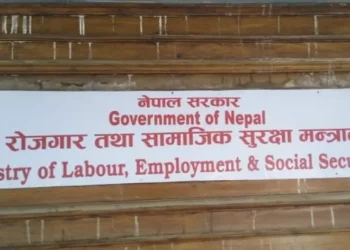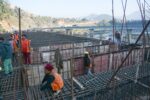KATHMANDU: The information and communication technology (ICT) sector in the country has made remarkable strides since the incumbent government was formed on July 13, 2021.
In this period, the current coalition government achieved significant success in the field of ICT towards realizing the vision of ‘Digital Nepal’.
All the services being rendered by the Department of Information and Broadcasting has gone digital since July 3 this year.
Online service systems such as Broadcasting and Radio License Management System (BRLMS), Documents Management System (DMS) and CAS/SMS online system.
The Information Management System was already put in place last year. Issuing press pass, identity card and renewable, online media registration and renewable, management of newspapers archive and public information management and distribution related works have been provided digitally, according to the Department’s director general Gogan Bahadur Hamal.
As the current fiscal year 2021/22 recently concluded, 2,092 press pass have been distributed while 2,557 were renewed within the fiscal year 2021/22.
Similarly, 662 new online portals were registered with the Department and 677 others were renewed during this period, informed director-general Hamal.
Dr Baikuntha Aryal, Secretary at the Ministry of Communications, Information and Technology, shared that around 90 percent of the Ministry’s services are being provided digitally at present towards achieving the vision of ‘Digital Nepal’.
The country that embarked on its first digital journey computing the census in 2028 BS using modern devices such as computer currently enjoys cent percent mobile phones’ penetration and 60 per cent access of internet.
Internet subscriber density has reached 116.91 per cent. Mobile phones’ penetration is recorded cent percent in the country while internet access stands at 60 per cent.
At the moment, 41,454,748 mobile phones are in use in the country. The basic fixed telephone’s usage has been on the wane with the growing use of mobile phones.
The density of telephone was recorded at 139.86 per cent and internet consumers’ density was at 116.91 as of mid-March, 2022.
This speaks volume for the notable milestone achieved for the vision of digitalization envisaged by various erstwhile governments over the period as well as the incumbent one.
The current five-party coalition government led by Nepali Congress has given continuity to reforms at policy, legal and structural level for overall development of communications and information technology sector.
Last fiscal year, National Cyber Security Strategy-2078 BS, National Broadcasting (11th Amendment) Regulations-2078 BS, Radio Communications (License) (Fifth Amendment) Regulations-2078 BS and Films (Production and Distribution) (Seventh Amendment) Regulations-2078 BS were endorsed by the Council of Ministers and already into effect.
Likewise, the Ministry of Communications, Information and Technology approved (Amendment) Order-2078 BS, Directives about website creation and management -2078 BS and issued Nagarik Apps (Operation and Management) Directives-2078 BS and Procedures related to 5G and other new technology related -2078 BS since the leadership of the incumbent government.
Also, Advertisement (To Regulate) Regulations-2077 BS was approved and Clean Feed policy is being enforced since 24 October, 2020.
As per the ‘Digital Nepal Framework 2076 BS’, the Ministry ensured increased of access of information and communication last fiscal year according to which 738 local levels offices, 6,190 ward offices, 5,299 community schools and 4,237 health centres had internet service installed by the end of last fiscal year.
The 15th periodic plan has taken the ‘Digital Nepal Framework’ as a transformational project.
Under the transformational project, 80 activities and eight sectors such as transportation, communication, health, education, energy, tourism, finance and agriculture were identified.
Talking to Rastriya Samachar Samiti (RSS), Spokesperson at the MoCIT Uttam Kumar Khattri said that the ‘Digital Nepal Framework-2076 BS’ was in the process of implementation.
According to him, software named ‘Automation’ was being used at the moment and many works were being carried out through email and internet.
“Comments also begin to be made/raise from here. Not only that, now have we also secured support from the World Bank for the transformational project,” he added.
The Ministry has also adopted the Digital Nepal Expression Project and it is expected to aid in effective implementation of the ‘Digital Framework Nepal.
Under the Integrated Work Management System, the Ministry’s subordinated agencies have been conducting their tasks such as raising comments, correspondence, record keeping of staffers and attendance digitally.
The other ministries in the Singha Durbar and other public offices will also follow the suit from the new fiscal year 2022/21 to being with first day of the Nepali month Sharawan (17 July).
The Digital Framework Nepal also envisages implementation of digital signature and to materialize the concept of ‘paperless governance’.
It also aims to establish internet as the basic and essential service, expansion of 5G network, laying of optical fiber network, high-speed broadband internet services in public offices for swift and effective public service delivery among others.
The Ministry also stated that the final version of Nagarik App was launched to effectively render services to public through government electronic (online service)’s integrated system.
The access of 4G service started by the Nepal Telecommunications has been expended to around 47 local levels till date.
The Fiber to the Home service, based on optical fiber, has been extended to 209 major cities in 64 districts across the country.
Construction of Information Highway by laying optical fiber was underway which connects Mid-Hill Highway and surrounding districts.
A total of 1,555 kilometres of optical fibers have been laid along the Information Highway and Wi-Fi hotspots are in operation in Muktinath Temple and Annapurna Circuit.
The government piloted the mobile device management system by connecting it to the National Information Technology Centre.
It will help curb the leakages of revenue as well as control criminal activities and irregularities conducted through mobile phones.
Among the achievements made by the government in a year include establishment of well-equipped information technology lab in 185 community secondary level schools.
Such labs contain at least 12 or up to 30 desktop (based on the number of students), laptops and screens.
The number of community schools having such high-tech information lab has reached 1,000 in the country.
Currently, 587 government agencies implement online attendance system. The machine for the same was, however, provided to 751 government offices, according to the Fiscal Survey-2021/22.
Of the 482 local levels receiving software, 357 have been operating it at present.
The National Spectrum Strategy has been put in place to ensure transparency in the distribution of frequency and to regulate it.
The government has been providing server, memory, storage and network in a low cost.
So far, space and resources have been allocated to 295 government offices to operate their information technology systems through the government cloud.
In-flight Aeronautical Telecommunications has been opened to provide telecommunication services in flight (above 10,000 feet in the sky) in the foreign-registered aircrafts.
In additional to that, work stations have been used to operate spectrum management system for developing countries and Nepal Telecommunication Authority’s GBTIMS.
A total of 30 IT human resources were trained for ‘Cyber Drill’ through Webinar under the capacity enhancement of the cyber security contact person and National Cyber Emergency Rescue Team members.
To make information technology secured, reliable in the government agencies and to reduce the cyber security related risks, IT security audit has been conducted in 44 public agencies.
Similarly, to manage the construction and operation of the information technology system of the government agencies in a more reliable and interconnected manner, standards, guidelines and ‘RT factor respirators’ of the Government Enterprise Examination (GEE) has been prepared and brought into effect.
Electronic Payment has been integrated with the Electronic Fund Transfer of the Office of the Comptroller General.
Moreover, Integrated SSS Gateway system is currently in operation in Office of the Comptroller, Transport Management System, Ministry of Physical Infrastructure Development and Bagmati Province. Mobile finance service has been piloted.
Mobile App built on common template for the local levels and integrated with the website being used by the local levels.
The digital wallet has been upgraded to be integrated with the service providers’ payment gateway.
This App has been used by 664 of the 753 local levels and efforts were underway to integrate this App with Nagarik App.
To digitalize the broadcasting of the Nepal Television, towers were built in Palpa, Hetauda and Buddhi Tola.
Construction of the towers for the Nepal Television has begun in Parbat, Rukum and Dadeldhura.
Ministry has started postal service via air services in Humla, Jumla, Mugu and Dolpa as well as Sankhuwasabha.
Postal services that was halted during outbreak and spread of COVID-19 pandemic in the country was resumed in Qatar, Malaysia, United Arab Emirates by inking agreement with the Nepal Airlines on 29 June, 2021.
Office Automation System, web-based software, has been operated in the postal offices across the country to digitally register the letters in the offices.
A total of 56 agreements were signed for effective postal services including 11 agreements from the surface post.
Validation of parcel delivery has been submitted to Universal Postal Union (UPU) this year out of the 40 per cent bonus that can be obtained at the rate issued by the UPU to determine the rate of the parcels in Nepal this year.
Through that, the transportation criterion has ensured a five percent bonus. Spots deemed suitable for film shooting have been identified in all seven provinces to develop those spots as film shooting spots.
According to the Film Development Board, Story Bank is ready to collect the unique stories to produce organic movies depicting stories various caste and communities through movie.
In order to start security printing within the country, process has been initiated and taken forward for procurement and installment of security printing having advance machinery, equipment, tools and software.
Fuel tank having capacity of 300,000 litres has been installed for operation of security printing press.
Chairperson at the Nepal Telecommunications Authority (NTA) Purushottam Khanal said that broadband internet was installed in 74 districts under 18 packages mobilizing funds from the Rural Telecommunications Development Fund.
Likewise, agreement was inked among the concerned parties to install and operate internet services for free of cost in the public offices, ward offices and schools for two years in the eight districts hardest hit by the Gorkha Earthquake on April 25, 2015.
Those districts were Kavrepalanchowk, Sindhupalchowk, Rasuwa, Nuwakot, Dolakha, Sindhuli, Ramechhap and Okhaldunga, according to NTA Chairperson Khanal.
RSS









Comment